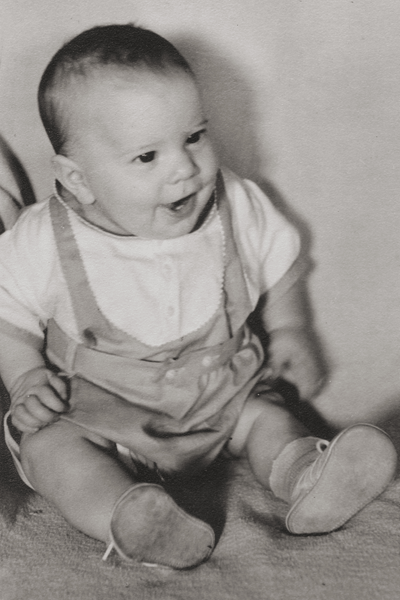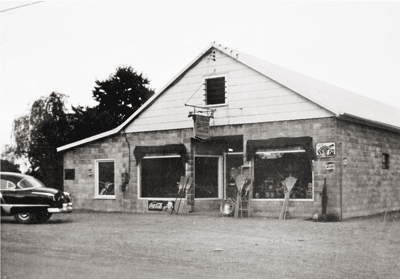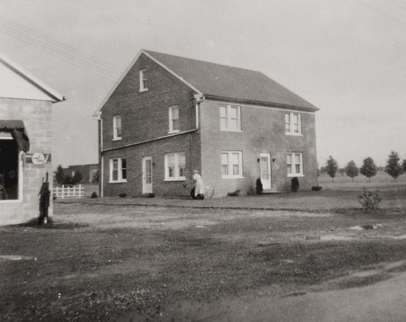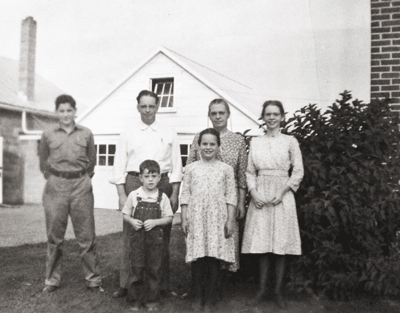|
1946-1950
I was referred to as the “baby of the family” and a ”New Year’s Baby” since I was the youngest and born on January first, 1946. That year, the first post-war babies were born, producing a “Baby Boom.” I was, along with others born on that first day of the year in 1946, the very first of the “baby boom.” We were children in the 50s, defined in the new era of TV as a time of sunny innocence. We came of age in the 1960s, experiencing the effects of massive social, artistic and political changes. The 60s decade included the Viet Nam war protests, the resurgence of folk music, the Beatles, Woodstock, LSD, Civil Rights, political assassinations, men on the moon and Richard Nixon. It was all on the radio, black and white TV newscasts, and in full color photographs in the weekly editions of Life Magazine. A magazine we did not have in our house and I did not see until my late teens.
Shortly after my birth, my parents built a two-story house next to the store. This house had a modern kitchen, a downstairs powder room and a full bathroom with bathtub upstairs. I have no memory of life before the new house, however, I have a few vague memories of being in a crib in Mother and Daddy’s bedroom. When I outgrew the crib, I was moved into the back bedroom on the north-east side. Janice and Gerri shared the bedroom on the south-east side. Our bedrooms were separated by the bathroom. Opposite the bathroom was the stairs to the first floor. The stairs separated the south-west “spare room” and the north-west bedroom Mother and Daddy shared. There was a door in their bedroom that led to attic steps.
We moved in before plaster was finished on the second floor and it remained that way through my teen years, just unfinished and unpainted plaster board. My parents invested profits into expanding the business and little was done to improve the house. My room was covered with graffiti from Nate, and later, notes and illustrations from me. I don’t remember Janice and Gerri writing on their gypsum board walls.
I must have shared that bedroom with Nate for a while. He is almost eleven years older than me and by the time I was moved out of my parent’s room, he would have been fourteen or fifteen. I’m sure in those early years I went to bed well before him and later, he went off to Eastern Mennonite College for a few years, before he married Anna Katherine Baer. I have very few memories of him at home. Gerri is almost eight years older than me and went off to college, so I do not have many memories of her at home either. Later, since she did not marry, she moved back home for a while. Janice, who is four years older than me, took college classes at the Hagerstown Community College that was called the “Junior College” because it only offered two-year degrees. I have many memories of Janice at home because we were closer in age and she was home while advancing her education and dating. None of us finished high school in classes, but we all achieved a high school equivalency certificate and attended some college courses. Gerri completed college with a degree in early education and went on to a Masters Degree in Deaf Education.
Some of my early memories include construction and expansion of the business. Shortly after the house was finished, a small addition was added to the side of the store. The addition was about fifteen feet wide and forty feet long. Mother managed a “dry goods” department in the new space. Later that department would be expanded. I think Mother liked having a part of the business that was mostly hers. Her “dry goods and notions” business catered to people, many of them Mennonites, who bought fabrics, buttons, and zippers to make their own clothes. She also sold clothes for children, shoes and “galoshes.” Mother specialized in items of clothing that were difficult to find but were part of the Mennonite dress code, like black hosiery for women, bonnets for little girls and hats for little boys. When pricing merchandise, my parents used a code consisting of ten letters. An item priced at $3.75 might have a code for example that would be SHY. As I grew to help in the store I learned that the secret code was based on the words, USE CHARITY, each letter representing a number from one to ten (ten being zero). The code SHY indicated that the the item priced at $3.75 in this example had a wholesale cost of $2.50. I remember feeling quite grown up when I learned the code.
We grow up so fast and so much happens in those few years of childhood and adolescence. When I think of those years, I remember my efforts to make a place for myself. When I was very young, I threw blankets over the picnic table and crawled under there. As my skills developed, I used scrap boards to build shacks behind the garage in the summers. In the winters, I cleared space in the attic, set up an old bed and a few pieces of discarded furniture to make my own place. Later in my teens, I convinced Daddy to let me turn part of the space above the store into a room for myself. I cleared out an area and closed it in. I purchased cheap materials and closed the rafters and created a ceiling. I built walls and a door. I had a rug on the floor, lamps, and a mattress. It was a ‘hippy pad’ before there were hippies with “pads.” When I wasn’t working in the store, I grabbed a soft drink and went upstairs to my own space. I had a record player. I remember listening to Dick Dale and Roy Orbison records!
As a young child, I played with cardboard boxes, drawing windows and doors. I also had Lincoln Logs, the erector set and electric trains. As I got older, I set up elaborate train layouts with houses and streets, complete with electric lights. Janice and Gerri taught me songs and rhymes. Gerri told me little stories she may have learned in school or at her week at Laurelville Mennonite summer camp. We each were permitted one week of summer camp at the age of twelve. For Gerri, that would have been 1950 and I would have been four years old. I remember the “Kee-mo-ki-mo Blue-Eyed Pussycat" song and some funny stories. I was at an impressionable age and some of it stuck with me. She also taught me the Bible verse from Galatians 5: 22 - 23, KJV “But the fruit of the Spirit is love, joy, peace, long-suffering, gentleness, goodness, faith, meekness, temperance: against such there is no law.” I never forgot that! Maybe because it seemed like religion was just so many rules and here was something that sounded positive! Best of all, there was, “No law” against any of it!
Someone gave us an old upright piano. Janice learned to play well enough that we could sing hymns while she played. Sometimes after dinner, when the dishes were done, we sang from the hymnal while Janice played. In the car, coming home from church, we sang “White Coral Bells” as a round. I was probably about five or six years old, Janice would have been ten and Gerri, fourteen. I could sing my part of the round and to me the harmonies sounded beautiful! Mother sang soprano.
My face was covered in freckles. I didn’t like having freckles. Gerri also had freckles. She told me that if you woke up early on April first and went outside and washed your face with dew from the grass your freckles would eventually disappear. I didn’t know about April Fools’ pranks. I tried it several times. Later, in my teen years, my freckles faded. Maybe it worked!
When I was four years old, Mother had a baby born in our house. That baby, a boy, died at birth. He was named Richard. I have a memory of being at Mother’s brother and sister-in-law’s house, Uncle Menno and Aunt Mary. They lived a few blocks away. Janice and Gerri were there, too, and were upset. I didn’t know why they were upset. I knew something was wrong. They went home but I had to stay. Later I was permitted to go home and I have a memory of the little casket in the back room of our house. If that memory is correct, it seems odd that it was in the back room but maybe it was only there temporarily. I think a bed was set up in that room for Mother and that is where the baby was born. I have a clearer memory of the small, graveside funeral at Marion Mennonite Church. Gerri was crying. She took this the hardest of us children partly because of her age at twelve, and because she was told that she would be the “Mother’s helper” with the baby. She thought of the new baby as being her real-life doll. I also think her age made her most sensitive to the sadness Mother was experiencing.
In addition to Mother’s tendency for depression, she now had lost a baby at birth, and experienced postpartum depression. She also had feelings of guilt, taking responsibility for the death of the newborn. Over the next several years, she was treated several times at Brooklane Mental Hospital. A treatment center that was affiliated with the Mennonite Church, it was there that she received electroconvulsive therapy in the early 1950s. She also started using medications. I heard references to Lithium and Valium. I remember being outside sort of playing but also being aware that I could not go into the house because Mother was crying. I didn’t understand why. I don’t know where Janice and Gerri were. Gerri says that she thinks they were mostly helping out in the store. Daddy was back and forth working and consoling Mother.
Mother’s problems with depression required periodic treatment throughout her life. We had a cistern under the kitchen. If you lifted a neatly concealed trapdoor in the hallway between the kitchen and the back room there was a wooden cover that could be lifted aside to access the cistern. One day I was watching Daddy nail that access door closed when he decided to tell me why he was securing it. I was twelve or thirteen and probably acted like it was no big deal when he said that he was nailing it shut because Mother was afraid she would end her life by jumping into the cistern. I guess I just put that information into a special file I was keeping in the back my brain.
Things Left Unsaid
mother is crying
in the kitchen while daddy
is in the next room
with a headache
balancing the books
I’m in the back yard
watching stones sail
from my slingshot,
a leather tongue
and shoestrings
David killing giants
and every stone goes further
across the empty lot
almost reaching the road
that runs from the school
to the airplane factory then
turns and stumbles toward
god knows what
12/07/06
Mother wanted to help people and she did it in the best way she knew, through the context of church attendance, and “acceptance of Jesus.” She believed that was the way to get your life on track and become “saved.” She adopted two families where the husband was alcoholic and had difficulty, or the inability, to hold a job. Mother gave them clothes and we took the wife and children to church with us on Sunday mornings. The children would often come and spend time with us in the summer.
One child came to stay. Ironically, like the baby she had lost, his name was Richard. We called him Dick (or Dickie). His parents gave permission for him to live with us. Maybe it was difficult for them to give him up, but they had twelve children and were living in poverty. He was not legally a foster child. It was just an arrangement between two families. He was six years old when he came and I was eight. Suddenly I had a brother. It was not always easy from my perspective. He was given freedom that I did not get. For example, for religious reasons I was not permitted to play little league baseball. He was permitted and became quite good at it. I was told to be a “good example.” I wanted more freedom and I did not want to be used as an example! However, in many ways, we were like real brothers. We shared a bedroom and played together and we fought. The relationship was even more complicated when he became a teenager and started to get into serious trouble. Dick embezzled money from the store and ran away from home on several occasions. Once when he had run away, a young female social worker visited us and talked with Daddy. Then she said to me, let’s drive around a bit and see if we can find Dick. I thought that was odd but I got in the car with her. She asked me where I thought he may be. I told her that I had no idea. Then she said, “Why don’t you like him?” I was speechless. I wondered why she asked me such a question and I began to question myself. Later when he was married, he continued to drink and would spend time in jail. I would go visit him in jail but it was strange and by then we had very little in common. After I left home, his sister came to live with my parents for a while. She seemed to do OK with them. At that time Daddy was more nurturing than Mother since she was dealing with her anxiety and depression. Eventually, this young girl moved to another, less restrictive Mennonite family.
I have often thought about my relationship with Dick. As a child and young teenager, I was not generous with him. I have very few memories of the time we spent together although it was a span of almost ten years. At times I think I made an effort but we did not have a bond that I imagine brothers can have. I do remember a few good times playing baseball in the back yard with Dick and neighborhood friends. Our back yard was big enough for a scaled down baseball diamond. We also played wiffle ball. We also took turns hitting the ball and catching flies. In the summer, when the concord grapes were ripe, we climbed into the grape arbor, and squeezed them out of the peeling and ate them until we were chased out by the bees. Dick and I had a fiberglas bow and arrow that we used to shoot target. We made slingshots. I worried when Dick was doing something dangerous or something that would get him into trouble.
Mother was creative and somehow found time for sewing and crochet projects. She designed and made blankets and quilts. Most Mennonite homes had simple wallpaper on the walls or pale yellow or beige paint. I remember the house painter, Russell Martin’s look of confusion, when Mother asked him to paint one of the dining room walls a deep, ultra-marine blue. I guess it was during one of her blue periods.
As I was growing up, Mother worked with Daddy in the store, from morning until night. She enjoyed meeting and talking with customers, and displaying merchandise. She and Daddy went on buying trips to the wholesale shops at the Baltimore harbor. I sometimes went with them. They would buy as much as the car would hold and Daddy was proud of how much he could pack in. We would eat lunch in a “White Coffee Pot Restaurant,” a small chain of diners in the Baltimore area. Daddy liked the breaded veal cutlet. I had hot turkey with gravy on white bread with mashed potatoes and canned green beans. I don’t remember what Mother ordered. Daddy would say a prayer before we ate. I was uncomfortable with the religious display. The way Mother and Daddy dressed was another oddity. It was at times like this that I realized how different we were. If we were somewhere far from home and we saw other Mennonites dressed like us, Mother would say, “Oh look, there goes some of our people.” On those buying trips to the city, I liked seeing the big ships in the harbor and the street vendors. There were still horse drawn carts with black men calling out their wares. It was mostly fruit and vegetables. They were known as “Arabbers.” There were street cars with ringing bells and sparks flying from the overhead wires. I liked going to Baltimore and looking at the street life and the harbor. In those days, Baltimore was known for its rowhouses where residents would wash and polish their identical, marble front steps. |
 |
Me at one year |
 |
Store with first dry goods addition |
 |
House when new, next to the store |
 |
Family standing with garage in background |
 |
Mother working in the store |
 |
Dickie and me looking at one of the encyclopedia books |
|





